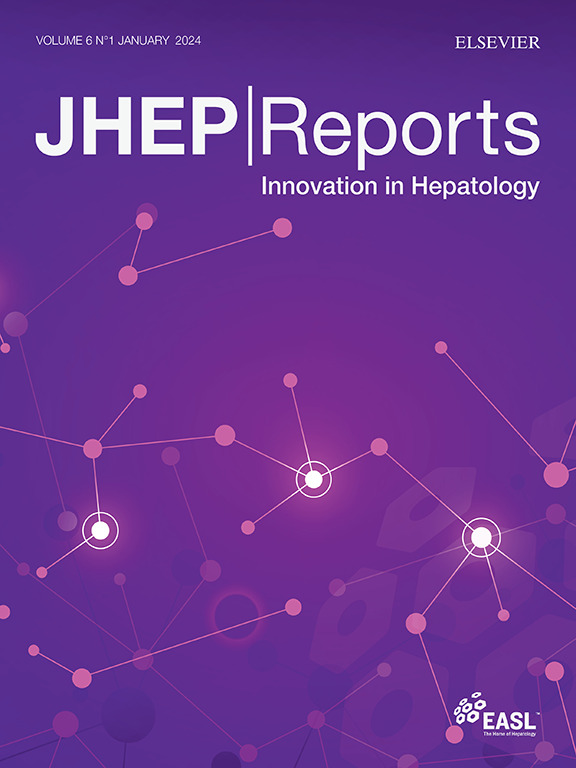利用先进的磁共振成像技术绘制特利加压素在肝肾综合征患者中的血流动力学效应
IF 9.5
1区 医学
Q1 GASTROENTEROLOGY & HEPATOLOGY
引用次数: 0
摘要
背景,aimsterli加压素可改善约40%的肝肾综合征-急性肾损伤(hr - aki)患者的肾功能。尽管如此,特利加压素的病理生理机制仍不清楚。因此,我们研究了特利加压素给hr - aki患者后发生的心血管变化。方法采用心脏和相对比磁共振成像技术评估10例HRS-AKI患者在首次注射2mg特利加压素后的心功能、肾脏、脏器和外周血流量变化,其中6例伴有急性慢性肝衰竭。采用Wilcoxon配对对带符号秩检验分析血流动力学变化。对患者进行前瞻性随访,以调查特利加压素引起的血流动力学变化与临床结果之间的关系。结果特利加压素治疗组心肌输出量(CO)下降15% (p <0.01)。尽管CO降低,但肾动脉血流量增加了23% (p <0.01),肾动脉血流量百分比增加了49% (p = 0.01)。肠系膜上动脉血流量和股动脉血流量分别减少27%和40% (p均< 0.01)。平均动脉压(MAP)和全身血管阻力分别升高13%和32% (p <0.01)。基线肾动脉血流与血清肌酐相关(p <0.01)。相比之下,肾动脉血流和其他心血管变量的变化与特利加压素后血清肌酐的变化或死亡率无关。结论利加压素可增加肾动脉血流量,降低CO,缓解内脏和外周血管舒张。这些作用,加上MAP的增加,似乎解释了特利加压素对rs - aki患者的治疗益处。影响和意义本研究首次提供了重症rs - aki患者特利加压素治疗后血流动力学变化的详细图谱。结果表明,特利加压素的有益作用是由选择性外周和内脏血管收缩驱动的,它可以重新分配血流,使MAP正常化,并最终改善肾灌注,尽管心输出量减少。该研究还强调了使用磁共振成像作为一种非侵入性方法来评估药物干预的优势,并有可能为肝硬化患者个性化医疗的未来发展做出贡献。临床试验注册nct03483272。本文章由计算机程序翻译,如有差异,请以英文原文为准。

Mapping the hemodynamic effects of terlipressin in patients with hepatorenal syndrome using advanced magnetic resonance imaging
Background & aims
Terlipressin improves renal function in ∼40% of patients with hepatorenal syndrome–acute kidney injury (HRS-AKI). Nonetheless, the pathophysiological mechanisms of terlipressin remain unclear. Therefore, we investigated the cardiovascular changes that occur after terlipressin is given to patients with HRS-AKI.
Methods
Cardiac and phase-contrast magnetic resonance imaging were used to assess cardiac function, as well as renal, splanchnic, and peripheral blood flow changes after the first bolus of 2 mg terlipressin in 10 patients with HRS-AKI, six of whom also had acute-on-chronic liver failure. Hemodynamic changes were analyzed using the Wilcoxon matched-pairs signed-rank test. Patients were followed prospectively to investigate any associations between terlipressin-induced hemodynamic changes and clinical outcomes.
Results
Cardiac output (CO) decreased by 15% following terlipressin (p <0.01). Despite this decrease in CO, renal artery blood flow increased by 23% (p <0.01), and the renal artery blood flow percentage of CO increased by 49% (p = 0.01). Superior mesenteric artery blood flow and femoral artery blood flow decreased by 27% and 40%, respectively (both p <0.01). Mean arterial pressure (MAP) and systemic vascular resistance increased by 13% and 32%, respectively (both p <0.01). Baseline renal artery blood flow correlated with serum creatinine (p <0.01). By contrast, changes in renal artery blood flow and other cardiocirculatory variables did not correlate with changes in serum creatinine after terlipressin or with mortality.
Conclusions
Terlipressin increases renal artery blood flow, reduces CO, and alleviates splanchnic and peripheral vasodilatation. These effects, combined with an increase in MAP, appear to explain the therapeutic benefits of terlipressin in patients with HRS-AKI.
Impact and implications
This study is the first to provide a detailed mapping of the hemodynamic changes following terlipressin treatment in patients critically ill with HRS-AKI. The results indicate that the beneficial effects of terlipressin are driven by selective peripheral and splanchnic vasoconstriction, which redistributes blood flow, normalizes MAP, and ultimately improves renal perfusion despite reduced cardiac output. This study also highlights the advantages of using magnetic resonance imaging as a non-invasive method to evaluate pharmacological interventions, with the potential to contribute to future advances in personalized medicine for patients with cirrhosis.
Clinical Trials registration
NCT03483272.
求助全文
通过发布文献求助,成功后即可免费获取论文全文。
去求助
来源期刊

JHEP Reports
GASTROENTEROLOGY & HEPATOLOGY-
CiteScore
12.40
自引率
2.40%
发文量
161
审稿时长
36 days
期刊介绍:
JHEP Reports is an open access journal that is affiliated with the European Association for the Study of the Liver (EASL). It serves as a companion journal to the highly respected Journal of Hepatology.
The primary objective of JHEP Reports is to publish original papers and reviews that contribute to the advancement of knowledge in the field of liver diseases. The journal covers a wide range of topics, including basic, translational, and clinical research. It also focuses on global issues in hepatology, with particular emphasis on areas such as clinical trials, novel diagnostics, precision medicine and therapeutics, cancer research, cellular and molecular studies, artificial intelligence, microbiome research, epidemiology, and cutting-edge technologies.
In summary, JHEP Reports is dedicated to promoting scientific discoveries and innovations in liver diseases through the publication of high-quality research papers and reviews covering various aspects of hepatology.
 求助内容:
求助内容: 应助结果提醒方式:
应助结果提醒方式:


